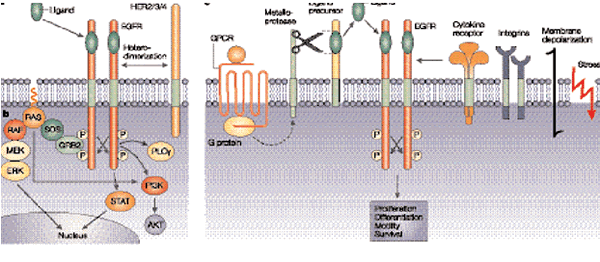
Figure
4: The epidermal growth factor receptor signalling
network. a |Ligand binding to the epidermal
growth factor receptor (EGFR) induces dimerization
through a receptor-mediated mechanism. Signal
diversification is generated by the presence of
multiple EGF-like ligands and the formation of
different dimeric receptor combinations. b | Receptor
dimerization results in cross-autophosphorylation
of key tyrosine residues in the cytoplasmic domain,
which function as docking sites for downstream
signal transducers. EGFR stimulation results in
activation of signalling cascades that include
the RTK–GRB2–SOS–RAS–RAF– MEK–ERK, PI3K–AKT, PLC??and
STAT pathways. EGFR can activate PI3K through
RAS-GTP in some cell types. c | EGFR acts as a
point of convergence for heterologous signals
from G-protein-coupled receptors (GPCRs; metalloprotease-mediated
EGFR signal transactivation), cytokine receptors,
integrins, membrane depolarization and agents
that are induced by cellular stress. The EGFR
thereby defines crucial cellular responses, such
as proliferation, differentiation, motility and
survival. ERK, extracellular-signal-regulated
kinase; GEF, guanine-nucleotide-exchange factor;
PI3K, phosphatidylinositol 3-kinase; PLC?, phospholipase
C?;STAT, signal transducer and activator of transcription.


